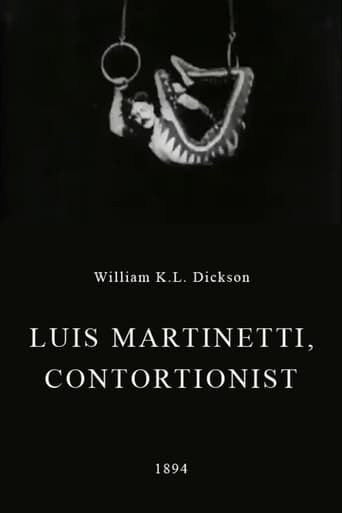He_who_lurks
Luis Martinetti was a contortionist from Italy. In this short piece, he carries out one of his routines, and if you weren't impressed by Hadj Cherriff, you will be by this guy! His act alone is of interest because you can tell that what he's doing ain't easy at all. You have to have a special limberness to do that and clearly he does. While most people today won't be interested in novelties like this, the act will interest some even if the historical interest isn't clear. The Unitard which Martinetti performs in is also a good choice as it makes it almost dazzling to watch him twist around and around. Less than 20 secs, no waste of time, and still watchable because it's more interesting than seeing a baby being fed. Martinetti is forgotten now but it's good the Edison Company made this movie about him.
cricket crockett
. . . or an Ode to the Cheshire Cat? This 16.03-second short begins with a somewhat limber guy grasping his feet with his hands as he hangs from the gymnastics apparatus known as the "Flying Rings." He has his head tucked neatly between his feet, like something out of ALICE IN WONDERLAND. Luis Martinetti is dressed in a white and dark lightning-striped Unitard, with each of his thighs poking through a 12-inch iron ring, leaving his teeny tiny butt against the back of his head! Next, he releases his feet and puts his hands on the lower outside quadrant of each ring. After briefly centering himself upright, he leans back and positions himself sideways--head to the left--and does four gyrations, holding his right heel with his left hand while clasping the bottom of the left ring with his right hand as the inside of his left leg is held up by the bottom of the right ring. (Do NOT try this at home!!) Luis than slowly dissolves from our view, just like the grin of Lewis Carroll's Cheshire Cat!
Michael_Elliott
Luis Martinetti, Contortionist (1894) This early Edison kinetoscope isn't going to be for most people but if you're a fan of early cinema then it holds enough historical interest to make it worth viewing. Luis Martinetti, forgotten today, shows what he can do on the flying rings as his acrobatic act is put on film for people to be able to view over a hundred years after it was made. While watching these very small movies I often wonder what those who took part in it would think if they were brought back and told that film buffs would still be viewing these films all these decades later. At just 25-seconds no one should be expecting any type of "story" or "performance" but that really doesn't matter but what's so interesting here is the bit of history we the viewer get to see. Martinetti is certainly forgotten today but thanks to Edison we at least get to see someone who people back in the day enjoyed and flocked to see. The film basically features him doing a few tricks on the flying rings and that's it. Nothing ground-breaking but it's still fascinating for fans of early cinema.
Snow Leopard
This short feature is of definite historical interest, as one of the very first of the Edison Company's films to be made available for viewing through their Kinetoscope. Filmed in Edison's 'Black Maria' studio, it does a good job for its time in filming its subject.Like a good many of the early Edison movies, this one features a popular vaudeville performer of the time. Luis Martinetti's act combined acrobatic skill with a surprising ability to bend and twist himself into unexpected positions. He does these in the movie with a minimum of props, and while it's not really all that exciting, you can see that it's not easy to do.This is one case in which filming in the studio with the very dark background works well, highlighting the performer while still allowing him what he needs for his act. The framing is good, and the occasional jumps in the footage may not have been there originally. The pace of Martinetti's movement seems to vary, but it's difficult to tell whether that was actually his pace, or whether the camera may simply have been cranked at different speeds.
